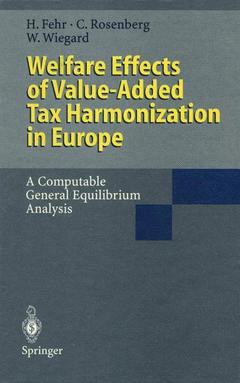Description
Welfare Effects of Value-Added Tax Harmonization in Europe, Softcover reprint of the original 1st ed. 1995
A Computable General Equilibrium Analysis
Authors: Fehr Hans, Rosenberg Christoph, Wiegard Wolfgang
Language: French
Subject for Welfare Effects of Value-Added Tax Harmonization in Europe:
Approximative price 52.74 €
In Print (Delivery period: 15 days).
Add to cart
Publication date: 01-2012
240 p. · 15.5x23.5 cm · Paperback
240 p. · 15.5x23.5 cm · Paperback
Description
/li>Contents
/li>
This book uses a computable general equilibrium framework to eval uate recent value-added tax reform proposals in the European Union from a welfare point of view. After the publication of the "White Paper" (1985) on the completion of the internal European market, an intense and heated debate about tax impediments to free trade set in. According to the original plans of the Commission of the European Union, not only physical border controls but also fiscal frontiers within the European Union would have been abolished on New Year's Day 1993. With respect to value added taxation this amounted to replacing the destination by the origin principle. Even though the origin principle had been favored by some economists from the establishment of a common European value-added tax system, time was not yet ripe for this change. In December 1991, the ECOFIN Council could only agree on the so called transitional system. In essence, these transitional arrangements maintain the destination principle as far as possible but shift the border tax procedure from national frontiers to firms. The transitional system is supposed to expire on December 31, 1996, with the final solution for value-added taxation in the European Union being decided upon by the ECOFIN Council until December, 1995. In the event of no decision the transitional arrangements will be continued. The most likely solution will be a switch to the origin principle combined with some clearing mechanism to prevent major revenue reallocations between member states.
I An Introduction to Value-added Taxation.- 1. The Development of Value-added Taxation in the European Union.- 1.1. From the Beginnings to the White Book.- 1.1.1. The Development of Turnover Taxes in Europe.- 1.1.2. The Treaty of Rome.- 1.1.3. Creating a European Value-added Tax.- 1.2. The VAT Harmonization Debate Since 1985.- 1.2.1. The White Paper.- 1.2.2. The 1987/89 Harmonization Proposals.- 1.2.3. A Tough Compromise: The Transitional System.- 1.2.4. What Comes After 1996?.- 2. Principles of Value-added Taxation.- 2.1. Types of Value-added Taxes.- 2.2. The Rate Structure of a Value-added Tax.- 2.3. Calculating Tax Liabilities.- 2.3.1. The Credit or Invoice Method.- 2.3.2. The Addition and the Subtraction Method.- 2.4. International Taxation Principles for VAT.- 2.5. One Further Issue in Value-added Taxation: Exemption Versus Zero Rating.- 3. Questions and Answers: The Plan of the Book.- 3.1. The Questions.- 3.2. The Methodology: Computable General Equilibrium Analysis.- 3.3. The Chapters to Come.- 3.4. Related Work.- II VAT Policy Options for an Integrated Europe.- 1. Some Basic Elements of our Model.- 2. The Destination Principle.- 2.1. Some Institutional Features.- 2.2. A Numerical Example.- 2.3. A More General Formulation.- 3. The Transitional System.- 3.1. Main Institutional Features.- 3.1.1. Intra-community Supplies and Acquisitions.- 3.1.2. Means of Transport.- 3.1.3. Distance Sales.- 3.2. A Numerical Example.- 3.3. A More General Formulation.- 3.3.1. The Switching Option.- 3.3.2. The Mixed System.- 4. The Origin Principle and the Credit Method.- 4.1. Some Institutional Features.- 4.2. A Numerical Example.- 4.3. A More General Formulation.- 4.3.1. The Common Market Principle.- 4.3.2. The Clearing System.- 5. The Origin Principle and the Subtraction Method.- III Theoretical Foundations.- 1. The Command Optimum.- 2. Tax Distortions.- 2.1. Tariffs, Income Taxes, and Production Taxes.- 2.2. Destination-based VAT.- 2.3. Origin-based VAT under the Credit Method.- 2.4. Origin-based VAT under the Subtraction Method.- 3. Trade Neutrality and the Exchange Rate Argument.- 3.1. Trade Neutrality.- 3.2. The Exchange Rate Argument.- 4. Welfare Effects of VAT in Open Economies.- IV From Theory to Application: A Computable General Equilibrium Model.- 1. Operationalizing Walras with CGE Models.- 2. The Theoretical Model.- 2.1. The Production Sector.- 2.1.1. Value Added and Composite Intermediate Products.- 2.1.2. Primary Input Demand.- 2.1.3. Demand for Domestic and Imported Composite Inputs.- 2.1.4. Demand for Imported Inputs.- 2.1.5. Calculating Producer Prices Under the Tax Credit Method.- 2.2. The Household Sector.- 2.2.1. Calculating Price Indices.- 2.2.2. Demand for Leisure and Consumption.- 2.2.3. Demand for Different Consumption Commodities.- 2.2.4. Demand for Domestic and Imported Commodities.- 2.2.5. Demand for Different Imported Commodities.- 2.3. The Public Sector.- 2.3.1. Public Revenues.- 2.3.2. Public Expenditure.- 2.4. The Foreign Sector.- 2.4.1. Balance of Payments.- 2.4.2. Terms of Trade.- 2.5. Equilibrium Conditions of the Model.- 3. A Micro-consistent Data Set for the EU.- 3.1. Consistency Requirements and Data Sources.- 3.2. Data Adjustments.- 3.2.1. Updating the Intermediate Transaction and Final Demand Tables.- 3.2.2. Value Added by Industry.- 3.2.3. Government Revenues and Expenditures.- 3.3. Some Final Remarks.- 4. Model Calibration.- 4.1. Specification of Exogenous Parameter Values.- 4.2. Calibration.- 4.2.1. Calibration in the Production Sector.- 4.2.2. Calibration in the Household Sector.- V Simulation Results and Economic Interpretations.- 1. Some Methodological Issues.- 1.1. Reliability of CGE Results.- 1.2. Measuring Welfare Changes from Tax Reforms.- 2. The Transitional System.- 2.1. The Switching Option.- 2.2. The Mixed System.- 3. The Origin Principle and the Credit Method.- 3.1. The Common Market Principle.- 3.2. The Clearing System.- 4. The Origin Principle and the Subtraction Method.- 4.1. Welfare and Revenue Effects.- 4.2. Equivalence of Statutory Tax Rates on Value Added and Effective Tax Rates on Consumption.- 4.3. Effective Consumption Tax Rates in General Equilibrium: An Example.- 4.4. Decomposing and Explaining Welfare Effects.- 5. Some Sensitivity Analysis.- 5.1. Varying Key Parameter Values.- 5.2. Varying the Data Set.- VI Summary and Conclusions.- List of Abbreviations.- Glossary of Notation.- The Debate about Value-added Taxation in the European Union: Timetable of Events since 1985.- References.
© 2024 LAVOISIER S.A.S.
These books may interest you

Taxation in European Union 89.66 €



